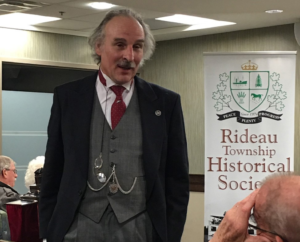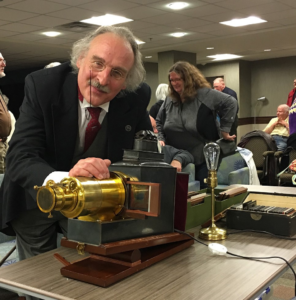Professor M. Lindsay Lambert’s Magic Lantern Show
Presented by Professor Lambert. Article by Sue Gibson. Photos by Owen Cooke. May, 2019.
In a darkened room with only the glow from an antique projector, the sight of “Professor” Lindsay Lambert, in his turn-of-the century outfit, created an excited stir throughout the audience. He brilliantly combined his skill as a performer, his love of history, and his expertise in vintage lighting and photography to enchant the audience with sound effects, song, and the patter of the traditional magic lantern projectionist.

The magic lantern was the first mass audience communication technology, invented in 1650 by Christiaan Huygens, a Dutch scientist. Many technological developments followed, including limelight that allowed brighter and larger images. By the middle of the nineteenth century, magic lantern shows were drawing audiences around the world. With its early forms of animation, the magic lantern also paved the way for motion pictures, the medium that would eventually eclipse it.
Prior to the 1850s the slides were hand painted and after that time they used photographic slides. The glass slides were encased in a wooden frame that allowed the projectionist to manipulate the slide, by turning a small wheel or lever within the slide to create a moving picture, such as a dancing skeleton, or shifting eyes within a skull. By the late eighteenth century, one of the most popular of the magic lantern shows were “Phantasmagoria” demonstrations, in which ghostly apparitions seemed to appear and vanish in the dark before the viewers’ eyes. It was a form of horror theater that used one or more magic lanterns to project frightening images, especially ghosts. Showmen used rear projection, mobile and portable projectors, smoke, and all kinds of effects to produce a convincing experience for the audience.
“Professor” Lambert drew upon his personal collection of many hundreds of glass slides and thrilled the audience with moving circus slides, including a knife juggler, a dog jumping through a hoop, a lion with moving eyes and mouth, and a twirling acrobat. Each slide was accompanied by a song or sound effects, resulting in resounding applause from the audience.
“Professor” Lambert’s keen interest and knowledge of history was demonstrated in the narrative that accompanied his early photographic slides of indigenous people, buffalo herds, Queen Victoria, and landmarks such as the Chaudière Falls. He explained that magic lanterns brought the world to the people. It was used extensively as a newsreel, a travelogue to encourage immigration, a lecture device to promote causes such as temperance and missionary societies, and by churches.
The presentation was followed by an enthusiastic question and answer period. He told the audience he purchased the magic lantern in 1982 from a local antique shop, even though it required some refurbishment. The evening ended with a demonstration of the “magic” levers and wheels on the slides. It truly was a magical evening!

